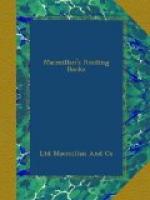HUGH MILLER.
* * * * *
THE FLIGHT OF BIRDS.
A good ornithologist should be able to distinguish birds by their air, as well as by their colours and shape, on the ground as well as on the wing, and in the bush as well as in the hand. For, though it must not be said that every species of birds has a manner peculiar to itself, yet there is somewhat in most kinds at least that at first sight discriminates them, and enables a judicious observer to pronounce upon them with some certainty.
Thus, kites and buzzards sail round in circles, with wings expanded and motionless; and it is from their gliding manner that the former are still called, in the north of England, gleads, from the Saxon verb glidan, to glide. The kestrel, or windhover, has a peculiar mode of hanging in the air in one place, his wings all the while being briskly agitated. Hen-harriers fly low over heaths or fields of corn, and beat the ground regularly like a pointer or setting-dog. Owls move in a buoyant manner, as if lighter than the air; they seem to want ballast. There is a peculiarity belonging to ravens that must draw the attention even of the most incurious—they spend all their leisure time in striking and cuffing each other on the wing in a kind of playful skirmish; and when they move from one place to another, frequently turn on their backs with a loud croak, and seem to be falling on the ground. When this odd gesture betides them, they are scratching themselves with one foot, and thus lose the centre of gravity. Rooks sometimes dive and tumble in a frolicsome manner; crows and daws swagger in their walk; woodpeckers fly with an undulating motion, opening and closing their wings at every stroke, and so are always rising and falling in curves. All of this kind use their tails, which incline downwards, as a support while they run up trees. Parrots, like all other hooked-clawed birds, walk awkwardly, and make use of their bill as a third foot, climbing and descending with ridiculous caution. Cocks, hens, partridges, and pheasants, etc., parade and walk gracefully, and run nimbly; but fly with difficulty, with an impetuous whirring, and in a straight line. Magpies and jays flutter with powerless wings, and make no dispatch; herons seem encumbered with too much sail for their light bodies; but these vast hollow wings are necessary in carrying burdens, such as large fishes, and the like; pigeons, and particularly the sort called smiters, have a way of clashing their wings, the one against the other, over their backs, with a loud snap; another variety, called tumblers, turn themselves over in the air. The kingfisher darts along like an arrow; fern-owls, or goat-suckers, glance in the dusk over the tops of trees like a meteor; starlings, as it were, swim along, while missel-thrushes use a wild and desultory flight; swallows sweep over the surface of the ground and water, and distinguish themselves




